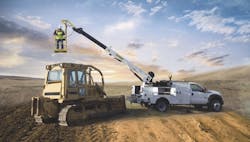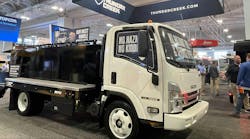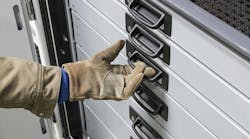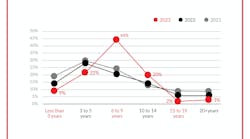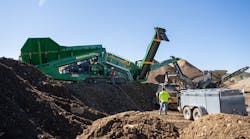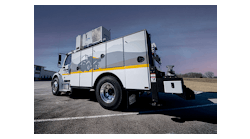Is it possible for maintenance managers to be prepared for absolutely anything out in the field? Some have tried by arming their mechanics’ and lube trucks to the teeth with as many bells and whistles as possible, but manufacturers point out that a smarter custom build that adds the right touches to a standard body can pay more dividends.
Today’s customization trends can also become tomorrow’s standard equipment.
“If we start to see trends on things, it’s the market that drives a lot of those things to us,” says Tim Davison, product manager for Stellar. “We probably don’t actively promote all the special items that we do today, but as they become more mainstream, they make their way into our price sheets, brochures and website. If there’s something totally new, we want to get to a proven stage before we mass introduce it to the marketplace.”
Some of the current trends include auxiliary power sources, modified and specially built tool compartments and drawers, and some less common accessories.
“One of the primary items that has changed in recent years is finding an alternative way to drive the hydraulic crane with a power source other than the chassis,” says Tim Worman, business development manager, IMT. “The benefit to that is they get a unit that has an air compressor in it, and a diesel- or gas-driven engine to drive that compressor and also the hydraulic systems for their crane—and they don’t have to have their chassis running.”
In addition, there have been developments with service trucks’ ubiquitous compartments.
“Taller compartments on units for more storage has been one that’s come about in the last few years,” Worman says. “The challenge with that is customers want more storage, but depending on the chassis it’s being mounted to, what that GVW is, they may not actually gain a lot more payload. The GVW of the chassis says you can only be loaded to a certain amount, but if you were to take a body that’s been increased in height, you may not be able to utilize it. So it’s a balance.
“We’re also seeing more sliding roofs over the load bed areas to protect them from the environment,” Worman says. “We’re seeing more trucks go out with auxiliary lighting, for doing more work at night. Also, we see different compartment lighting for increased visibility. At the end of the day, whether the manufacturer does it or the equipment upfitter does it, there’s a litany of customization that could take place.”
Where there’s light, there can also be heat.
“We’re seeing heaters in compartments,” Davison says. “If someone has a set of tools that they don’t want to get condensation on, or want to make sure that certain diagnostic tools aren’t cold, we’ll actually put in heaters so they’re warming up those compartments.”
Davison says requests for heated compartments are primarily coming from the mining industry. “It seems like larger mining equipment is more electronic technology-focused, so they have more specialty tools to service the equipment,” he says.
There is also a movement to add hydraulic circuits. “Some companies that we’ll put hose machines in for, some of them will run hydraulic tools, so we’ll put a hydraulic circuit in for hydraulic jacks and rams,” Davison says.
“People are also more conscious about corrosion than they’ve ever been,” he adds. “With the advent of magnesium chloride on roads and calcium chloride getting on equipment and roadways, corrosion is probably worse now than it’s ever been, so we’re having to do more to combat that. We have to look at the material that we use, make sure that it’s suitable, and we have to look at the way we prep and coat the material.
“We can’t just drill a hole and put a bolt through; if you do that, you have to make sure you’re coating that hole with something so that it’s not bare steel,” Davison says.
A number of customers have also shown interest in taking weight out of standard units. “First we look at a customer’s applications and ask, ‘Are we overbuilt?’” Davison says. “Generally we’re not, so we look at what items on our bodies can go to a different material, whether it’s aluminum or some kind of composite. Are there things we can do that won’t affect the structural integrity of the unit? After all we’re often supporting a crane that lifts thousands of pounds.
“I think more and more companies are looking at going to aluminum, with Ford looking at going to aluminum on the Super Duty chassis this next year,” Davison says. “More body companies are asking ‘How do we incorporate aluminum and other composites into our products sensibly where we can reduce weight and help with corrosion but also keep the structural integrity where we need it to be for long-term use?’”
Davison points out that much of the emphasis on weight is not out of fear of DOT regulations, but from an increased awareness of cost as a result of better fleet-management practices. It’s a development that may affect future customization in the service truck industry.
“[Concerns about] DOT probably gets the biggest rap for it, but a lot of guys are becoming more understanding of what their fleet costs are, and in doing that, they understand that if they run a truck that’s heavier versus one that’s closer to maximum capacity, things wear out quicker, the cost of maintenance goes up, so therefore that unit costs them more,” Davison says.
Likewise, managers have to think about getting their money’s worth on utilization, as well as possible disposal.
“We’ve built trucks for one customer, that due to specific work clearing earth for a new airport, had to have a larger body, larger capacities, but the truck stayed on the job site,” IMT’s Worman says.
“They went from a 14-foot body on a single-rear-axle Class 7 truck to 19-foot bodies on Class 8 chassis because they needed more parts storage. They needed to have every conceivable, potential part for the equipment they were working on carried on those vehicles because the downtime had such a negative impact on the job. They had to keep everything running and try to plan for worse-case scenarios,” Worman says.
“The hope is that they can use it after the fact, but that’s not always the case,” he continues. “Keep in mind that when you go through that [customization] process, having a truck that is overspec’d to the job is just as detrimental as a truck that is underspec’d for the job. If a customer only utilizes something 30 percent of the time, he’s not getting the return on his investment. You’ve got to be able to demonstrate the utilization on that mechanics’ truck, no different than you would have to justify the utilization on an excavator.
“The flip side is being underspec’d, which we see more often than not, where a customer will order one based on capex dollars and not truly on what the truck will be doing. You’re going to have increased cost in it because you’re overworking it, you’re overutilizing it,” Worman says.
“So your life-cycle cost increases because of its own preventive maintenance work, its own service that needs to be done because it’s basically wearing it out faster than it should be. There’s a fine balance between the two.”
As far as disposal is concerned, managers have to decide whether their trucks, customized or not, have worth on the secondary market. Stellar’s Davison says there is another option.
“Depending on how long it’s been serving in the field, more customers want to take the equipment off and mount it on a new chassis,” he says. “Some want to run a truck 7-10 years and dump the truck; it’s more of a cost than an asset, so put it on secondary market and start over fresh. However, the cost of service trucks and the cost of truck chassis has gone up so much that I think more people are investigating if there’s a way they can remount equipment on a chassis. They see a truck that has a ton of hours on it, but the equipment doesn’t have a ton of hours on it.”
Remounting equipment is something service truck providers have to be careful about promoting in order to protect sales, much like the decision on what they will and won’t do for customization.
“If we do something customized, we really want to see it as a derivative of a standard product,” Davison says. “If we can start with a standard product and modify from there, it’s certainly a lot easier to design, it’s easier to manufacture, it’s easier for us to be successful for the customer.
“So if it has a genesis with a standard product, there’s a lot of things that we’ll do, whether it’s compartment depth, compartment heights, removing compartments and making accessories that go inside a compartment, those are all things that we can succeed very well at for a customer,” Davison says.
“I’m starting to see a trend in the market where there is a little less customization,” Worman says. “Fleet managers, being more business savvy now, they recognize that anytime they customize a unit, it costs them more money. They’re starting to really look at the utilization of their fleet and ask, ‘Do we really need to have trucks that do this, do they really need to be custom built? Can we get away with having a couple with standard specifications?’
“They recognize that they can control their capex spending on that and also have more consistency in the preventive maintenance programs, because they don’t have a lot of the special items—they start to control that life-cycle cost more,” Worman says. “They’re still going to have the instances where they need something special, but I see more of a trend to get away from that. In the old days, when money was flowing like water, they just ordered whatever they wanted.”
Just how far manufacturers will go to customize also depends on economic factors.
“It’s really contingent upon the economic conditions at the time,” Worman says. “You look at a customer that has a need, and when we were in the downturn, every manufacturer was hungry to keep their businesses whole, keep their employees whole, and would tend to do more customization than when the economy is going strong and lead times are long. In good times, they’re trying to push customers to more standard product with a little tweaking.
“Right now, everybody’s busy. We still do a fair amount of customization for our customers at the manufacturing level, but I think at the distributor level they do much more of that customization,” Worman says.
“But as a manufacturer, when you are slow, you tend to do more, when you’re busy, you tend to do less and push it to your distributor,” he says.
“Our economy ebbs and flows; a lot of companies reevaluated their business practices in the last downturn because there was a lot of wasted money in there, so you hear economists talk about the new norm,” Worman continues.
“We’re kind of in that with mechanic’s trucks now. What’s the new norm and what’s it going to be going forward so the customer reduces their risk in the next downturn? Too much inventory got written off with the last crash. Nobody wants to go through that again.”
